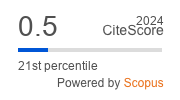Preventive citicoline administration is more effective than therapeutic in model of transient cerebral ischemia in rats
https://doi.org/10.47093/22187332.2019.2.21-28

Full Text:
Abstract
Aim. To study changes in the concentration of neurospecific proteins (NSE and S100B) and neurological status in model of focal transient cerebral ischemia in rats with preventive and therapeutic administration of citicoline. Materials and methods. The work was performed on 51 male rats weighing 180-220 g. We investigated the effectiveness of intraperitoneal injection of citicoline (2000 mg/kg) in model of transient 60-minutes intravasal occlusion of the left MCA in preventive single (EP group, n=12) and daily therapeutic administration (ET group, n=14). The control group was represented by 25 animals, of which 8 were falsely operated (CWI group - control group without ischemia), 17 were simulated cerebral ischemia (CI group - control group with ischemia). In all subgroups was evaluated the neurological status according to the Bederson scale and the concentration of neurospecific proteins (NSE and S100B) in the blood plasma before and at 1, 3 and 5 days after modeling of cerebral ischemia. When comparing groups, the nonparametric Wilcoxon test and the Mann-Whitney U-test were used.Results. In the CI subgroup, on the first day after ischemia modeling, there was a significant increase in the level of NSE and S100B, respectively, to 232 and 309% from baseline ( p <0.01) with a subsequent tendency to a slight decrease. The average neurological score in this subgroup on the Bederson scale for all 5 days of observation was 2.5±0.1. In the ET subgroup, there was no statistical difference in the dynamics of changes in the concentrations of neurospecific proteins and neurological status in the first 5 days of the postischemic period compared to the CI subgroup. In rats of the EP subgroup, the dynamics of changes in NSE and S100B in compared with the initial level, was characterized by an increase in their concentration to 193 and 253%, respectively. In comparison with the subgroups of CI and ET, the increase in concentration was less pronounced ( p <0.01). The average neurological score in this subgroup for 5 days of observation was significantly lower than in the CI and ET subgroups and was 0.8±0.2 ( p <0.01).Conclusion. In model of cerebral ischemia in rats the effectiveness of citicoline is more pronounced with its preventive than the therapeutic using. Further clinical studies are needed on the efficacy of citicoline prophylactic use.
About the Authors
G. Z. Sufianova
Tyumen State Medical University; Federal Center of Neurosurgery
Russian Federation
A. A. Sufianov
Federal Center of Neurosurgery; Sechenov First Moscow State Medical University (Sechenov University)
Russian Federation
A. G. Shapkin
Tyumen State Medical University; Federal Center of Neurosurgery
Russian Federation
M. S. Khlеstkina
Tyumen State Medical University; Federal Center of Neurosurgery
Russian Federation
A. M. Mashkin
Federal Center of Neurosurgery; Sechenov First Moscow State Medical University (Sechenov University)
Russian Federation
R. A. Sufianov
Sechenov First Moscow State Medical University (Sechenov University)
Russian Federation
Views:
1000






































